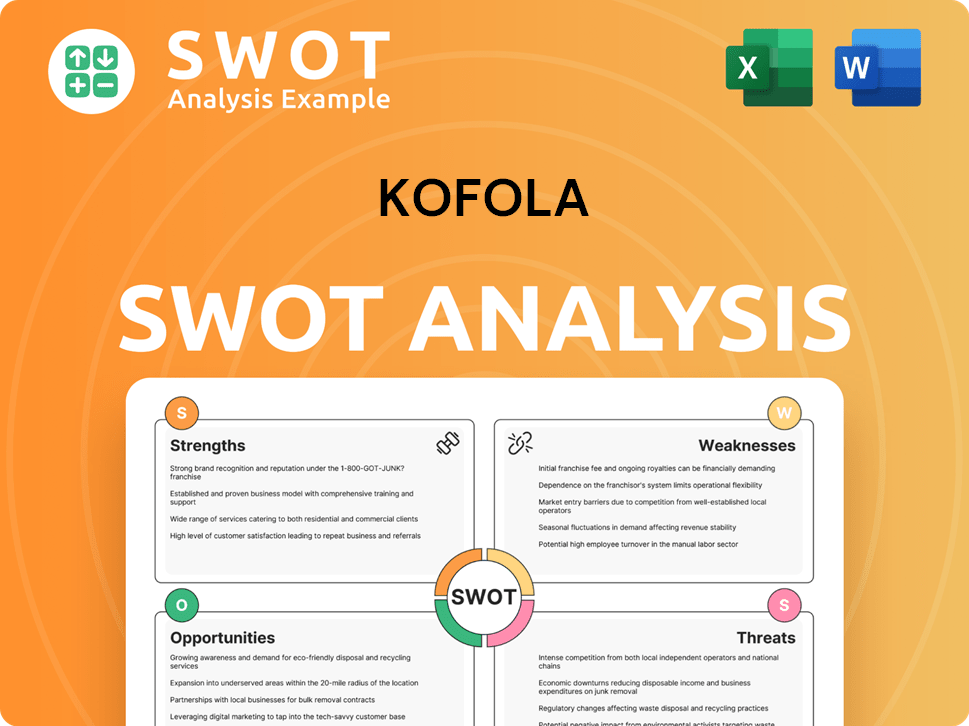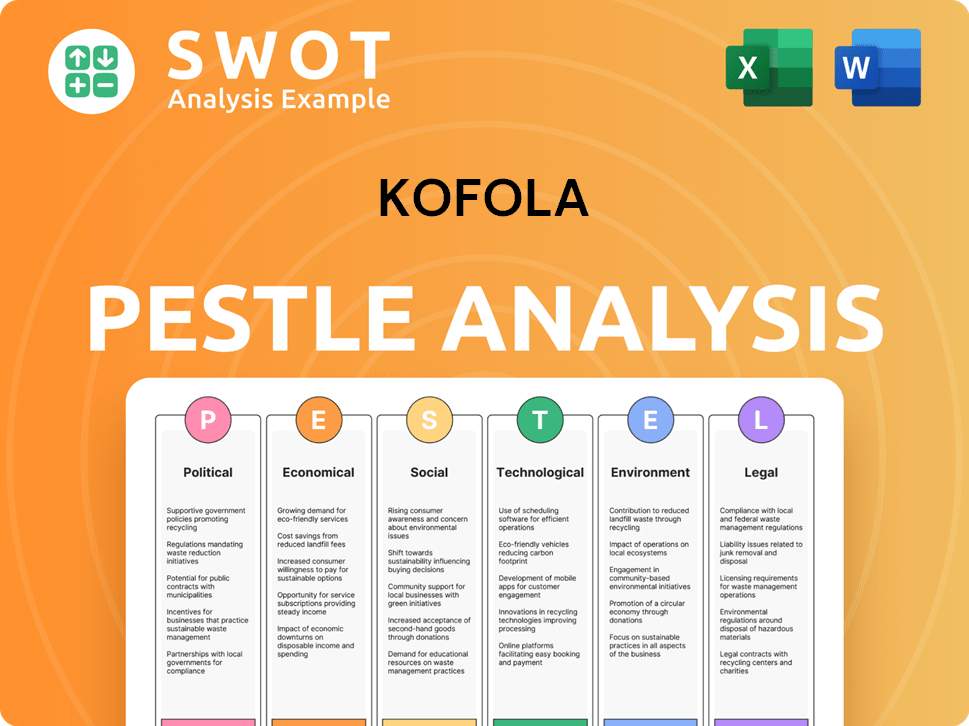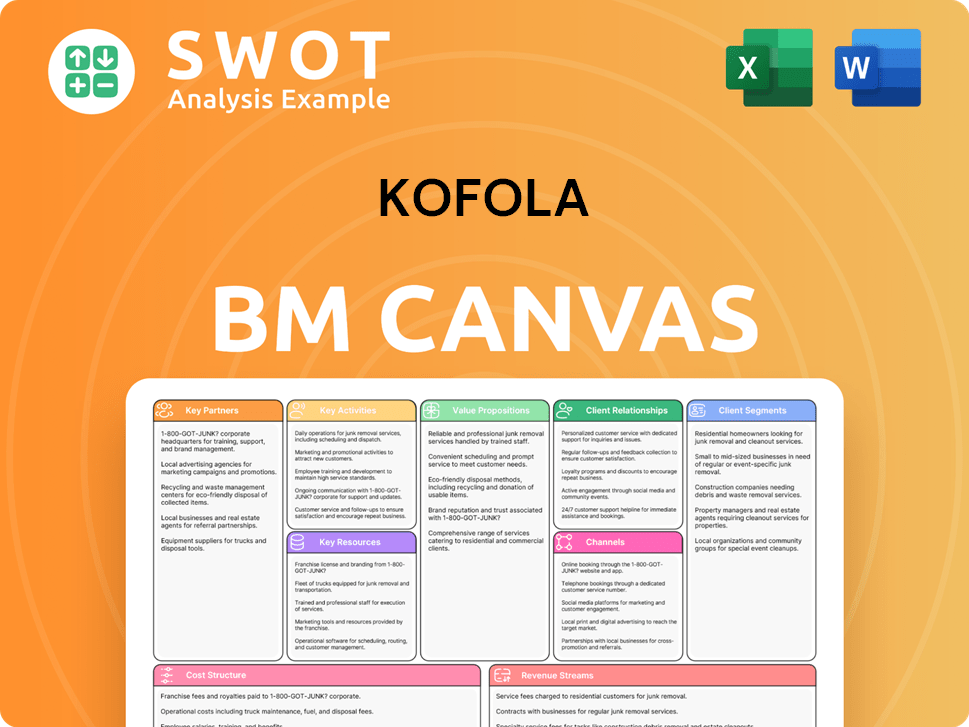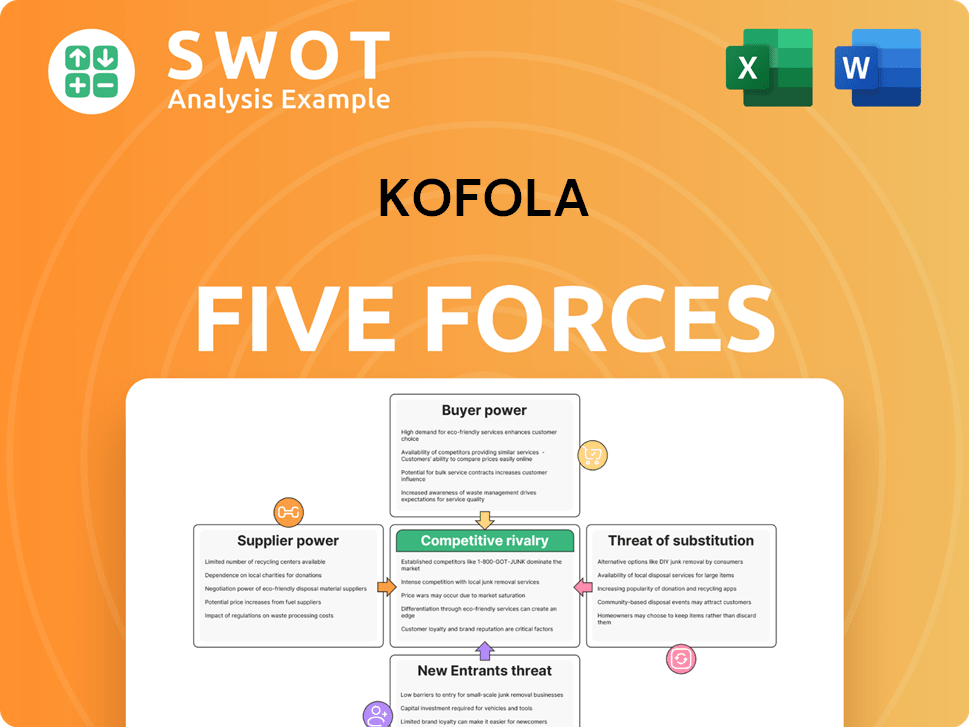Kofola Bundle
How did Kofola rise from behind the Iron Curtain?
Kofola's story is more than just a Kofola SWOT Analysis; it's a tale of ingenuity and adaptation. Born in Czechoslovakia in 1960, the Kofola company crafted its namesake beverage as a resourceful response to the scarcity of Western products. This innovative spirit, fueled by necessity, propelled Kofola from a local alternative to a major player in the beverage industry. Discover the fascinating Kofola history.

From its Kofola origin, the company navigated the communist era and emerged as a beloved brand. Today, Kofola ČeskoSlovensko a.s. stands as a testament to resilience and strategic growth, offering a diverse portfolio of beverages. Understanding the brief Kofola history provides valuable insights into its market strategies and enduring appeal, exploring how Kofola became a significant player in the cola market, and its popularity over time.
What is the Kofola Founding Story?
The Kofola history began in 1960, a period when Czechoslovakia was under communist rule. The genesis of the
The
The name 'Kofola' itself is a clever combination of 'kofein' (caffeine) and 'kola,' clearly indicating its core ingredients and target market. Initial funding for the project came from the state, aligning with the centrally planned economy's structure. The creation of Kofola was a strategic move to offer a local alternative, shaping its early production history and reflecting the era's cultural and economic context.
The founding of Kofola was driven by the need to utilize excess caffeine and provide a domestic cola alternative.
- The original recipe, developed by Dr. Zdeněk Blažek, was for a syrup called 'KOFO'.
- The beverage was designed for the state-controlled distribution network.
- The name 'Kofola' is a portmanteau of 'kofein' and 'kola'.
- Initial funding came from the state, reflecting the communist era's economic structure.
Kofola SWOT Analysis
- Complete SWOT Breakdown
- Fully Customizable
- Editable in Excel & Word
- Professional Formatting
- Investor-Ready Format

What Drove the Early Growth of Kofola?
The early growth of the Kofola company is a significant part of its brief history. Following its introduction in 1960, the Kofola beverage quickly became a national favorite in Czechoslovakia, establishing itself as a household staple. The initial product was the Kofola syrup, which was then carbonated and served. This period set the stage for the company's future expansion and evolution.
Kofola's popularity soared, becoming a cultural icon during the communist era. Its widespread distribution across Czechoslovakia, with minimal competition from Western brands, solidified its market position. The Kofola drink ingredients were a closely guarded secret, adding to its mystique and appeal.
The Velvet Revolution in 1989 brought both challenges and opportunities for the Kofola company. Privatization and the influx of Western brands created a more competitive market. The company had to adapt to survive and thrive in the new economic landscape.
The acquisition of the license to produce Kofola in Krnov, Czech Republic, in 1993 marked a turning point. The early 2000s saw significant expansion, including the acquisition of Radenska mineral water company. This period was crucial for establishing a strong presence in Slovakia.
The strategic focus was on re-establishing brand loyalty and expanding its geographical footprint. New flavors and packaging options were introduced to broaden its appeal. For more insights, consider reading about the Growth Strategy of Kofola.
Kofola PESTLE Analysis
- Covers All 6 PESTLE Categories
- No Research Needed – Save Hours of Work
- Built by Experts, Trusted by Consultants
- Instant Download, Ready to Use
- 100% Editable, Fully Customizable

What are the key Milestones in Kofola history?
The Kofola company has a rich Kofola history, marked by significant milestones, starting with its Kofola origin and evolving into a prominent beverage producer in Central and Eastern Europe. Key moments have shaped its journey, from its inception during the communist era to its successful re-establishment post-privatization.
| Year | Milestone |
|---|---|
| 1959 | The Kofola beverage was created in Czechoslovakia as a response to the unavailability of Western cola drinks. |
| 1960s-1980s | Kofola became a popular drink throughout Czechoslovakia, establishing a strong brand presence. |
| 1990s | Following the Velvet Revolution, Kofola was privatized, marking a crucial turning point for the Kofola company. |
| 2002 | The company was re-established and began expanding its product portfolio and market reach. |
| 2000s-2020s | Kofola expanded its portfolio through strategic acquisitions, including brands like Rajec, UGO, and Radenska, and expanded its geographical footprint. |
| 2024-2025 | Kofola continues to adapt to market changes, focusing on healthier options and expanding its presence in the Central and Eastern European markets. |
Innovation has been a core strategy for the Kofola company, driving its growth and market position. The company has consistently broadened its product range beyond its original cola-like drink.
Kofola expanded its portfolio to include mineral waters, juices, and functional beverages to cater to diverse consumer preferences. This included brands such as Rajec, Kláštorná Kalcia, UGO, and Jupí.
The acquisition of brands like Radenska in Slovenia and Hoop Cola in Poland demonstrated Kofola's ambition for regional dominance. These acquisitions helped to broaden its market reach and product offerings.
Kofola strategically focused on the 'healthy hydration' segment, investing in natural waters and fresh juices. This shift responded to changing consumer preferences for healthier options.
Kofola invested in robust marketing campaigns that leveraged nostalgia and national identity, differentiating itself from international competitors. These campaigns helped maintain a strong brand image.
Kofola has increasingly focused on sustainability, including initiatives to reduce its environmental impact. This includes investments in renewable energy and sustainable packaging.
Kofola has embraced digital transformation, utilizing online platforms and social media to engage with consumers and enhance its brand presence. This approach includes e-commerce and digital marketing.
Despite its successes, the Kofola Czech Republic has faced several challenges. Intense competition from global beverage giants and shifts in consumer preferences have significantly impacted the company.
Kofola faced intense competition from global beverage giants like Coca-Cola and PepsiCo, particularly after the opening of the Central European markets. This competition required Kofola to differentiate itself through unique branding and product offerings.
Economic downturns and changes in consumer spending habits have presented challenges. These economic fluctuations can impact consumer demand and require adjustments to pricing and marketing strategies.
Shifts in consumer preferences towards healthier options have presented obstacles. Responding to the demand for healthier beverages required the company to innovate and diversify its product portfolio.
Global events have caused supply chain disruptions, impacting the availability of raw materials and increasing production costs. These disruptions can affect production and profitability.
Changes in regulations, such as those related to sugar content and environmental standards, have required Kofola to adapt its product formulations and production processes. Compliance with new regulations can increase costs.
The beverage market is highly competitive, with many established brands and new entrants. This saturation requires continuous innovation and strong marketing to maintain market share.
Kofola Business Model Canvas
- Complete 9-Block Business Model Canvas
- Effortlessly Communicate Your Business Strategy
- Investor-Ready BMC Format
- 100% Editable and Customizable
- Clear and Structured Layout

What is the Timeline of Key Events for Kofola?
The Kofola company has a rich history, marked by significant milestones that have shaped its journey from its Kofola origin to its current status as a prominent beverage producer. The brief Kofola history showcases the evolution of the brand, its adaptation to market changes, and its expansion across Central and Eastern Europe. Here’s a look at some of the key moments in the Kofola company timeline.
| Year | Key Event |
|---|---|
| 1960 | Kofola syrup was developed in Czechoslovakia, marking the beginning of the Kofola beverage. |
| 1962 | Kofola was officially launched and distributed, introducing the unique taste to consumers. |
| 1989 | The Velvet Revolution led to market liberalization, opening new opportunities for Kofola. |
| 1993 | Santa nápoje acquired the license for Kofola production in Krnov, a key step in its growth. |
| 2002 | Kofola a.s. was established, consolidating operations and setting the stage for further expansion. |
| 2004 | The acquisition of Radenska, a Slovenian mineral water company, broadened the product portfolio. |
| 2008 | The acquisition of Hoop Cola in Poland expanded its regional presence significantly. |
| 2015 | Kofola ČeskoSlovensko a.s. listed on the Prague Stock Exchange, enhancing its market profile. |
| 2018 | Acquisition of a majority stake in Espresso, further diversifying its beverage offerings. |
| 2020 | Kofola celebrated 60 years of its iconic Kofola drink. |
| 2024 | Kofola reported strong financial results, with sales growing by 11.2% in the first nine months of 2023, reaching CZK 6.6 billion, demonstrating its continued success. |
Kofola is focused on growing its presence in Central and Eastern Europe. The company is exploring new product categories to align with health and wellness trends. This includes expanding its distribution networks. Kofola is aiming for a sales target of CZK 10 billion by 2027.
Kofola is committed to environmental responsibility. Plans include increasing the share of recycled PET in its bottles. The company is also focused on reducing its carbon footprint. The company is adapting to the increasing demand for sustainable packaging.
Kofola is likely to be influenced by industry trends, such as the rising demand for functional beverages and plant-based alternatives. The company emphasizes innovation while maintaining its brand heritage. The company's leadership is committed to staying true to the brand's founding vision of providing quality beverages.
Kofola aims to achieve an EBITDA of CZK 1.5 billion by 2027. The company is building on its strong regional identity. The future outlook for Kofola is one of sustained growth. This is achieved by adapting to evolving consumer preferences.
Kofola Porter's Five Forces Analysis
- Covers All 5 Competitive Forces in Detail
- Structured for Consultants, Students, and Founders
- 100% Editable in Microsoft Word & Excel
- Instant Digital Download – Use Immediately
- Compatible with Mac & PC – Fully Unlocked

Related Blogs
- What is Competitive Landscape of Kofola Company?
- What is Growth Strategy and Future Prospects of Kofola Company?
- How Does Kofola Company Work?
- What is Sales and Marketing Strategy of Kofola Company?
- What is Brief History of Kofola Company?
- Who Owns Kofola Company?
- What is Customer Demographics and Target Market of Kofola Company?
Disclaimer
All information, articles, and product details provided on this website are for general informational and educational purposes only. We do not claim any ownership over, nor do we intend to infringe upon, any trademarks, copyrights, logos, brand names, or other intellectual property mentioned or depicted on this site. Such intellectual property remains the property of its respective owners, and any references here are made solely for identification or informational purposes, without implying any affiliation, endorsement, or partnership.
We make no representations or warranties, express or implied, regarding the accuracy, completeness, or suitability of any content or products presented. Nothing on this website should be construed as legal, tax, investment, financial, medical, or other professional advice. In addition, no part of this site—including articles or product references—constitutes a solicitation, recommendation, endorsement, advertisement, or offer to buy or sell any securities, franchises, or other financial instruments, particularly in jurisdictions where such activity would be unlawful.
All content is of a general nature and may not address the specific circumstances of any individual or entity. It is not a substitute for professional advice or services. Any actions you take based on the information provided here are strictly at your own risk. You accept full responsibility for any decisions or outcomes arising from your use of this website and agree to release us from any liability in connection with your use of, or reliance upon, the content or products found herein.